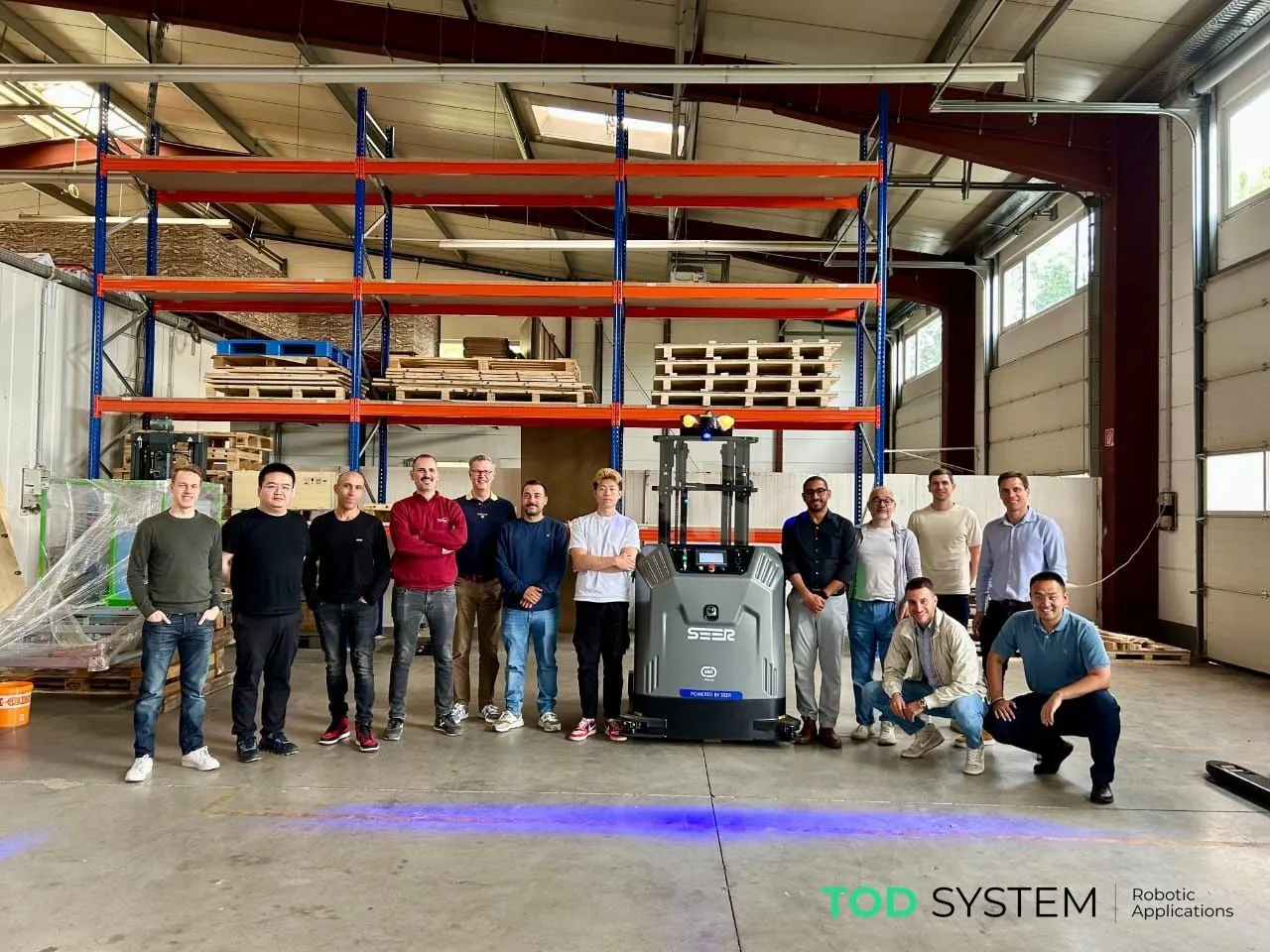In today's modern industrial environment, characterised by ever-increasing competition and the need to improve production efficiency, palletisation plays a key role in ensuring a fast, accurate and cost-effective logistics flow. This process, which consists of the orderly and secure arrangement of products on pallets for transport and storage, is often subject to inefficiencies, errors and high costs when performed manually. Companies are therefore looking for innovative solutions to optimise this critical stage of production.
The introduction of cobots (collaborative robots) is radically transforming the way companies approach palletisation, bringing automation, precision and flexibility to workflows. Thanks to their ability to work in synergy with human operators and their ease of programming, cobots enable the automation of repetitive and physically demanding tasks, significantly reducing the risk of errors and optimising the use of company resources. This translates into higher productivity, reduced operating costs and increased safety in the workplace.
By implementing cobot-based palletising solutions, companies can benefit from a more efficient, scalable and adaptable process to changing market needs, while achieving a rapid and measurable return on investment. Thanks to their ability to integrate seamlessly into existing processes, cobots are an effective response to the challenges of modern manufacturing, enabling companies to improve their competitiveness and respond with greater agility to supply chain demands.
1. Traditional palletising and its challenges
Manual palletising, although still widely used in many production environments, presents numerous obstacles that can negatively affect operational efficiency and worker safety. Despite its apparent simplicity, this activity involves several issues that companies have to face on a daily basis:
- Operator fatigue: Repetitive lifting and handling of heavy loads can cause a high level of physical stress for workers, increasing the risk of musculoskeletal injuries. This not only reduces the productivity of workers, but can also lead to periods of sick leave and additional costs related to occupational safety management.
- Operational inefficiency: Unlike automated systems, which can run without interruption, manual palletising is subject to slowdowns due to operator fatigue, the need for breaks, and variable speed. This can cause production bottlenecks and limit the company's ability to fulfil high order volumes in a short time frame.
- Human errors: The repetitiveness of the process and operator fatigue can increase the likelihood of errors, such as misplacing products, incorrectly overlapping layers and creating unstable pallets. Such errors compromise the quality of the packaging, affect the safety of handling and can generate waste or damage products.
- High costsThe use of labour exclusively dedicated to palletising leads to high operating costs, especially in sectors where demand varies seasonally or requires a sudden increase in production capacity. In addition, the need for continuous training and staff turnover add further expenses to business management.
These critical issues highlight the need for a more efficient and reliable solution capable of improving company productivity and reducing operating costs without compromising process quality. In this scenario, palletising automation through the use of cobots represents a strategic opportunity to optimise operations and respond to evolving market needs.
2. Cobots: an innovative solution for palletising
To address the many critical issues of traditional palletising, cobots are emerging as a revolutionary technological solution, combining advanced automation, safety and operational flexibility. Unlike traditional industrial robots, cobots are designed to interact directly with human operators, working in synergy with them to optimise the production process without the need for cumbersome safety barriers or dedicated environments. This makes them particularly suitable for companies wishing to improve efficiency without disrupting the layout of existing production facilities.
Here are the main advantages that cobots offer over traditional palletising systems:
- Secure collaboration: Cobots are equipped with advanced sensors and control systems that detect the presence of operators and adapt their speed and force to ensure safe interaction. This drastically reduces the risk of accidents in the workplace and allows operators to work side by side with robots without danger.
- Operational flexibilityOne of the main strengths of cobots is their ability to be easily reprogrammed to adapt to different palletising configurations. Whether for products with variable dimensions or customised stacking schemes, cobots can be quickly reconfigured to meet new production requirements without requiring long downtimes.
- Low cost and fast return on investment: Compared to traditional industrial robots, which often require high investments and dedicated facilities, cobots are a cheaper and more accessible solution. Their initial cost is lower and, thanks to reduced downtime and increased productivity, the return on investment can be achieved much more quickly.
- Ease of integration: Cobots are designed to be implemented in existing production processes with ease. Thanks to their intuitive interface and user-friendly programming, even operators with no robotics experience can quickly learn how to use them, reducing training costs and the time needed for commissioning.
3. Benefits of automation with cobots in palletising
Palletising automation through cobots offers a number of significant benefits, improving productivity, reducing operating costs and increasing the quality of work. Let's look at the main benefits in detail:
- Increased productivity: Cobots can operate non-stop, working around the clock without breaks, fatigue or reduction in performance. Thanks to their efficiency, cycle times are optimised, speeding up the palletising process and ensuring greater production capacity than manual methods.
- Reduction of operating costs: The use of cobots for palletising lowers labour costs by reducing the need for personnel for repetitive and physically demanding tasks. Furthermore, the lower incidence of accidents at work leads to a reduction in safety-related expenses and sick leave, improving the economic sustainability of the production process.
- Greater accuracy and consistency: The cobots ensure accurate and repeatable positioning of products on pallets, eliminating errors resulting from human fatigue or varying operator performance. This results in higher packaging quality and more efficient logistics, with perfectly balanced pallets that are safe for transport.
- Operational flexibility: Thanks to their intuitive interface and advanced programmability, cobots can be quickly adapted to different packaging formats and palletising schemes. This allows companies to respond with agility to changes in market demand and production requirements without the need for long downtimes or costly plant modifications.
4. Implementation of palletising solutions with cobots
The adoption of cobots for palletising is not limited to the purchase of a robot, but requires careful strategic planning and effective integration into the existing production process. Here are the key steps for successful implementation:
- Existing process analysis: Before introducing a cobot, it is essential to conduct a thorough analysis of the current workflow, identifying inefficiencies and areas for improvement. This step helps to define the specific goals of automation, such as increasing productivity, reducing costs or optimising packaging quality.
- Selecting the appropriate cobot: Choosing the right cobot depends on several factors, including load capacity, robotic arm reach and compatibility with existing production lines. It is also essential to assess safety features and ease of programming to ensure smooth integration.
- Design and simulation: Before the actual installation, it is advisable to use simulation software to test the operation of the cobot within the production layout. This makes it possible to identify any criticalities, optimise the positioning of the robot and ensure efficient integration with other operations.
- Training and support: The success of the implementation also depends on the preparation of the personnel. It is important to provide employees with adequate training on programming and maintenance of the cobot to ease the transition and ensure effective use of the technology. In addition, continuous technical support is essential to solve any problems and maximise operational efficiency.
5. Success stories: companies that have transformed palletising with cobots
Numerous companies in various sectors have already successfully adopted automated palletising solutions with cobots, achieving significant improvements in efficiency, cost reduction and operational quality. Here are some concrete examples:
- Food sector: A major packaging company implemented cobots to optimise the palletising process, resulting in a 30% reduction in processing time and a 25% reduction in packaging errors. This resulted in better quality control and increased productivity.
- Logistics and distribution: A large distribution centre adopted cobots to handle the increasing volume of orders, improving execution speed and reducing operating costs. Thanks to automation, the company was able to process more orders with a lower incidence of palletising errors.
- Pharmaceutical industry: The use of cobots enabled a pharmaceutical company to ensure compliance with strict safety and quality regulations by automating the palletisation of sensitive products. This has improved the efficiency of the process, minimising the risk of contamination and ensuring high packaging accuracy.
6. Future of palletising: continuous innovation with cobots
As artificial intelligence and machine learning technologies advance, cobots will become increasingly sophisticated. Future innovations include:
- Greater decision-making autonomy: The cobots will be able to dynamically adapt to changes in workflows, optimising operations in real time.
- Integration with IoT: Connection with IoT systems will enable constant monitoring and predictive maintenance, reducing downtime.
- Advanced collaboration: New algorithms and sensors will improve the interaction between cobots and human operators, ensuring smoother and safer cooperation.
Conclusion
The introduction of cobot-based palletising solutions is a key strategic choice for companies wishing to optimise their production processes, significantly reduce operating costs and increase their competitiveness in the global market. Thanks to their high flexibility, cobots allow rapid adaptation to changes in production lines or specific requirements, thus ensuring continuous optimisation of workflows. In addition, their advanced security, which allows direct collaboration with operators without the need for protective barriers, contributes to safer working environments and improved operational efficiency. Easy integration with existing systems in production facilities is a further advantage, minimising implementation time and costs.
In this context, cobots are emerging as one of the key technologies for the evolution of industrial automation, capable of responding to future challenges in a more agile and responsive manner than traditional solutions. Companies that decide to invest in these innovative solutions today will not only be able to improve their production capacity and product quality, but will also be able to face emerging market challenges with greater efficiency, resilience and adaptability. At a time when automation and technological innovation are crucial for long-term success, the adoption of cobots is a choice that looks to the future, preparing to respond to the needs of an ever-changing market.






